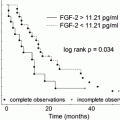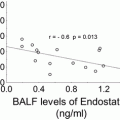Sarcoidosis
Controls
p
(n = 111)
(n = 65)
Age (years)
44.8 ± 10.4
43.3 ± 12.4
BMI (kg/m2)
28.2 ± 3.9
26.8 ± 5.6
0.091
FAS
22.9 ± 7.9
17.0 ± 3.3
0.046
MRC
1.3 ± 0.8
1.1 ± 0.3
0.028
OCD
1.6 ± 0.8
1.1 ± 0.3
0.025
Borg’s scale
0.7 ± 1.3
0.1 ± 0.1
0.010
FI
1.7 ± 1.1
1.1 ± 0.3
0.007
MT
1.8 ± 0.9
1.2 ± 0.5
0.032
ME
1.9 ± 1.0
1.2 ± 0.5
0.006
FI + MT + ME
5.5 ± 2.9
3.5 ± 1.2
0.004
PF
50.7 ± 7.4
54.8 ± 4.0
0.007
RP
45.2 ± 10.7
53.7 ± 5.4
0.003
BP
46.3 ± 10.0
51.1 ± 10.8
0.106
GH
40.2 ± 11.7
51.0 ± 4.8
0.001
VT
49.9 ± 9.7
54.9 ± 10.7
0.061
SF
47.1 ± 12.1
49.5 ± 9.7
0.160
RE
50.3 ± 12.1
52.0 ± 7.6
0.065
MH
43.7 ± 10.6
47.9 ± 9.0
0.238
PCS
46.4 ± 9.2
54.1 ± 5.1
0.010
MCS
47.3 ± 11.4
49.2 ± 9.9
0.176
Significant differences between sarcoidosis patients and controls were observed in the perception of dyspnea. These differences were confirmed in all dyspnea questionnaires used (MRC, OCD, Borg’s scale, and BDI). The quality of life estimation showed inappreciable differences between sarcoidosis and control subjects in the SF-36 domains that reflect mental aspects: BP, VT, RE, MH and MCS. There were, however, significant differences in the domains that reflect physical aspects: PF (50.7 vs. 54.8; p = 0.007), RP (45.2 vs. 53.7; p = 0.003), GH (40.2 vs. 51.0; p = 0.001), and PCS (46.4 vs. 54.1; p = 0.01, respectively) (Table 1). The results of lung function and cardiopulmonary exercise tests were in the patients within normal range.
3.1 Sarcoidosis Patients Stratified by Steroids Consumption
There were no differences in age and BMI between sarcoidosis patients taking and non-taking steroids (Table 2). Nor were there differences in the mean FAS results of sarcoidosis patients regarding steroid consumption. The patients on steroids had a higher dyspnea score than those not taking steroids only in the MRC questionnaire (1.4 vs. 1.2, respectively; p = 0.043); other dyspnea, quality of life, and lung function results were inappreciably different between these two subgroups of sarcoidosis patients.
Table 2
Physical and clinical characteristics of the sarcoidosis patients stratified by steroids consumption
Clinical data | Taking steroids | Non-taking steroids | p |
|---|---|---|---|
Gender (F/M) | 3/45 | 1/46 | 0.039 |
Age (years) | 45.1 ± 10.2 | 43.4 ± 11.3 | 0.232 |
BMI (kg/m2) | 27.8 ± 2.9 | 28.4 ± 4.8 | 0.414 |
FAS | 21.7 ± 6.9 | 22.0 ± 7.9 | 0.819 |
MRC | 1.4 ± 0.6 | 1.2 ± 0.6 | 0.043 |
OCD | 1.7 ± 0.9 | 1.4 ± 0.7 | 0.357 |
FI | 1.8 ± 1.0 | 1.5 ± 1.0 | 0.305 |
MT | 2.0 ± 1.0 | 1.4 ± 0.8 | 0.102 |
ME | 2.1 ± 1.0 | 1.6 ± 0.9 | 0.125 |
FI + ME + MT | 6.1 ± 2.9 | 4.6 ± 2.6 | 0.096 |
PF | 47.5 ± 9.4 | 53.2 ± 5.0 | 0.485 |
RP | 38.5 ± 12.0 | 50.5 ± 6.3
Stay updated, free articles. Join our Telegram channel
Full access? Get Clinical Tree
 Get Clinical Tree app for offline access
Get Clinical Tree app for offline access

|


